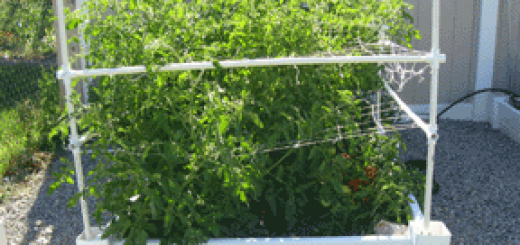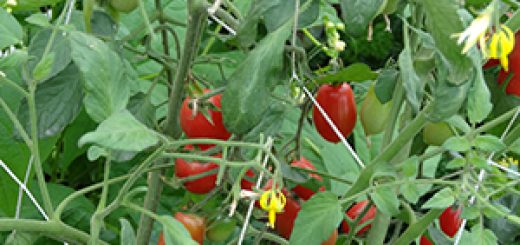Fertilizer for Vegetable Gardens
 When roaming down the aisle of gardening products, are you slightly baffled by the three number code that appears on the labels of the fertilizer? Wonder no more!
When roaming down the aisle of gardening products, are you slightly baffled by the three number code that appears on the labels of the fertilizer? Wonder no more!
There are three main nutrients that plants need to grow and thrive: Nitrogen, Phosphorus, and Potassium (think back to high school chemistry and remember that “K” is the symbol for potassium). All commercially packaged fertilizers have a set of numbers that correspond with these elements–those numbers indicate the percentage of that nutrient.
10-10-10 contains 10% nitrogen, 10% phosphorus, and 10% potassium
16-16-8 contains 16% nitrogen, 16% phosphorus, and 8% potassium
21-0-0 contains 21% nitrogen and no phosphorus or potassium
When a fertilizer contains all three elements, it is called a “complete fertilizer.”
What balance of nutrients to add depends on your soil. In this article I will assume that you are using a soil mix of compost, peat moss, and vermiculite.
Nitrogen
Nitrogen is essential for lush, green vegetation. But be careful–add too much and you’ll get lots of leaves and no fruit! Potatoes, corn, and onions need LOTS of nitrogen (about 4x’s what other vegetables require), while peas and beans need less.
Phosphorus
Phosphorus promotes healthy root growth, flowering, and fruit. When there is an extreme deficiency, the leaves will turn purple, but moderate deficiencies result in small plants and stunted growth. This element is less available during cool temperatures, so it may be important to add it early in the spring.
Potassium
Potassium promotes thick, sturdy stems in fruiting plants and higher yields from root vegetables. A deficiency leads to long, spindly stems and weak plants. This element is less available during cool temperatures, so it may be important to add it early in the spring.
Trace Elements
Besides these major nutrients, plants need several trace elements to grow well–like calcium, zinc, iron, boron, and manganese. Zinc and iron deficiencies cause the leaves to turn yellow or tan in between dark green veins.
Putting it all together
My recommendation for those using Mel’s mix is to combine 1 cup of 16-16-8 complete fertilizer with 1/4 cup of Ironite mineral supplement. Sprinkle and mix into the top 6-8 inches of soil before planting in the spring.
Be sure to purchase plant fertilizer instead of slow release lawn fertilizer. It is much less expensive to purchase bulk–either keep it for years to come, or divide among some gardening friends.
| Amount | Size | Square Feet |
|---|---|---|
| 1/3 cup | 4’x4′ | 16 sq ft |
| 2/3 cup | 4’x8′ | 32 sq ft |
| 1 cup | 4’x12′ | 48 sq ft |
Organic alternatives
For those who prefer to fertilize only with organic materials, you have lots of options. I love Jerry Baker’s Backyard Problem Solver and Giant Book of Garden Solutions
. He includes tons of home made recipes to help in the garden.
There are also commercially available organic sources–blood meal (N), fish meal (N), mushroom compost (P), bone meal (P), seaweed (K), and wood ashes (K) are some examples. Just combine them in the same proportions listed above, and fertilize away!
Another obvious choice is to create and add compost to the garden. Just a quick word of warning–if you add organic materials that are not yet decomposed they can create a shortage of nutrients in the garden. But if you allow microorganisms to work their magic, your grass clippings, food scraps, leaves, and manure can be a gold mine!





Hi. I admit I get frustrated with all the different numbers for different things.
I have a fish fertilizer I bought which is described as being all purpose and “use on all indoor and outdoor plants” It’s 5-1-1…. Can I really use that for everything? I guess the idea of buying different things for my onions then tomatoes then flowers etc bugs me. Last year I forgot to use fertilizer at all! (but it was really hot last year and I didn’t want to go outside…. everything I grew – tomatoes, squash, strawberries and potatoes – did fine… but this year I’m putting alot more in and am going to pay more attention.)
BTW I got to your site via how to grow onion sets. I tried a FEW last year – they were really scallons – and ironicly I did get some little onions that I still have some of. This year I bought three kinds of onion sets and I’m planning on planting them tomorrow. (note- I’m in colorado – and the last month we have had weekly snow with very cold temps. otherwise I’d have planted them earlier – hard to do when your garden area is under snow.)
I don’t know much about organic fertilizing. Read more about fertilizer here. 16-16-8 means 16% nitrogen, 16% phosphorous and 8% potassium. You’d need to match that.
I love your site and all the great info. My question is about the organic alternatives and how to make an organic version fertilizer similar to 16-16-8? Would I just mix 16 parts of blood meal (for Nitrogen), 16 parts bone meal (for Phosphorus), and 8 parts kelp meal (for Potassium)? Then measure 1/3 cup of the mixture to add to my 4×4 garden? Or would I have to do a soil test for the missing nutrients and add only what is missing?
Do you live where there might be a local farm coop? I find those are well supplied with good products.
i am looking for a lowe nitregen fertilizer for sweet potatoes i have looked at all the supper stores
Since the article and half the comments mention 10-10-10, a note about it is required. Same-number fertilizers were invented to capitalize on people’s vague instinct that “balanced” = good. But in fact, there is not one single plant in your garden that wants the same amounts of those three nutrients. (Not even if you average all the plants in your grid.)
A good fertilizer will have three different numbers. There is no “right” one to get, because your soil/compost/etc. already has different amounts of these three nutrients in it. So what you need more of will depend on what you already have. Too much of one isn’t much better than too little.
A great way to decide is to do a soil test and only add what it shows you’re missing. The symptoms in this article should also tell you if you’re missing a nutrient. Or you could look up your specific plants to see what they typically want. It varies, but the “vegetables” tag here can give you specifics. And one expert I know of says to stay close to a ratio of 3:1:2, in whatever strength you get. There are different approaches. Just please don’t reward the misleading makers of 10-10-10 with your money.
Diane–the kind I get is sold at IFA (Intermountain Farmers Association) and I think it’s their mix. You can go with a 10-10-10 or a 20-20-20. The main point with the fertilizer is to get something wtih roughly equal parts of everything, instead of just nitrogen.
I have been searching for 16-16-8 fertilizer without success. What is a brand name for this ratio? Also, what amount do you add for a 12-inch square to ensure each plant type gets what they need? Newbie needs some H-E-L-P!
Norma–you should be able to find something like 10-10-10 at Wal-Mart, Home Depot, or Lowes.
Hi it’s me again I think I didn’t get an OK yet it was September 28, just have a question about the fertilizer? can’t seem to find the 10-10-10? Thanks for your help, just love this site..
Very cool site!!! Thank you for the info.
Not sure–other than to add compost as a mulch? I feed mine with chemical and/or organic fertilizers.
Getting started with my first SFG in the hill country of Texas. Mel says to “feed” each square once a month, but no where can I see how much of the mix to use for each 12″ square. Help!
Christie–start with 16-16-8, or something very similar, and incorporate it at the rate I listed above before planting your vegetables. If you’ve never used fertilizer before, this is a good first step and you can stop here.
If you want to fertilize more, follow the instructions on the individual vegetable information pages. Different vegetables have different needs.
I am confused. Which of the 3 fertilizers (10-10-10/ 16-16-8 or 21-0-0) do you buy? How often do you use them?
thank you.
Thanks for the info! Your site makes gardening seem much less intimidating to me.
Perfect, thank you!
Heather–you can buy Ironite at any IFA though I would not be surprised to find it at WalMart or Home Depot.
Thank you so much for the helpful information! Last year was my first year of SFG. I followed Mel’s instructions to a “T”. My lettuce, spinach, peas, carrots, and strawberries did wonderful. However, I got maybe 1 small tomato, a small handful of grape tomatoes, and probably 3 (total) green beans, and none of those plants grew big at all. I figured that it needed some sort of extra “umph” but according to the SFG book, you shouldn’t need to add anything extra, so I didn’t. Over the winter I decided I needed to add some sort of fertilizer and I was going to go pick it up tomorrow so I can plant my cold weather seeds, so this info is VERY helpful. Thank you! I clicked on the Ironite link above and put in my zip code, and it said it’s not available here. (I’m in UT County) Do you know where I can purchase it? Thank you so much- I don’t comment much, but I love your blog!
Adam–the 5-10-10 has only 1/3 of the nitrogen, which usually is the nutrient plants need in the greatest amount. You could add an equal amount of 12-0-0 to make it comparable. The benefit of doing a single fertilizer is that fertilizer is in the form of salt, and if you add too much your soil will be negatively impacted.
1/3 cup of 20-20-20 has twice as much nutrients as 1/3 cup of 10-10-10. So if you have lower numbers you may have to add more to compensate. Again, you might run into salt problems.
I’ve been making my own fertilizer for two year now and love it! I have the recipe on my blog:
http://mysweetshack.blogspot.com/2010/04/how-to-make-your-own-liquid-fertilizer.html
Great info! Love your site. My beds haven’t done as good as i would’ve expected and i think its because I need to add some fertilizer. Thanks for your reccomendations; it takes the guess work out. I already have a box of 5-10-10. Would that work just as well as the 16-16-8, or should I get the 16-16-8? Aslo, if it does work would I use it in the same ratios?